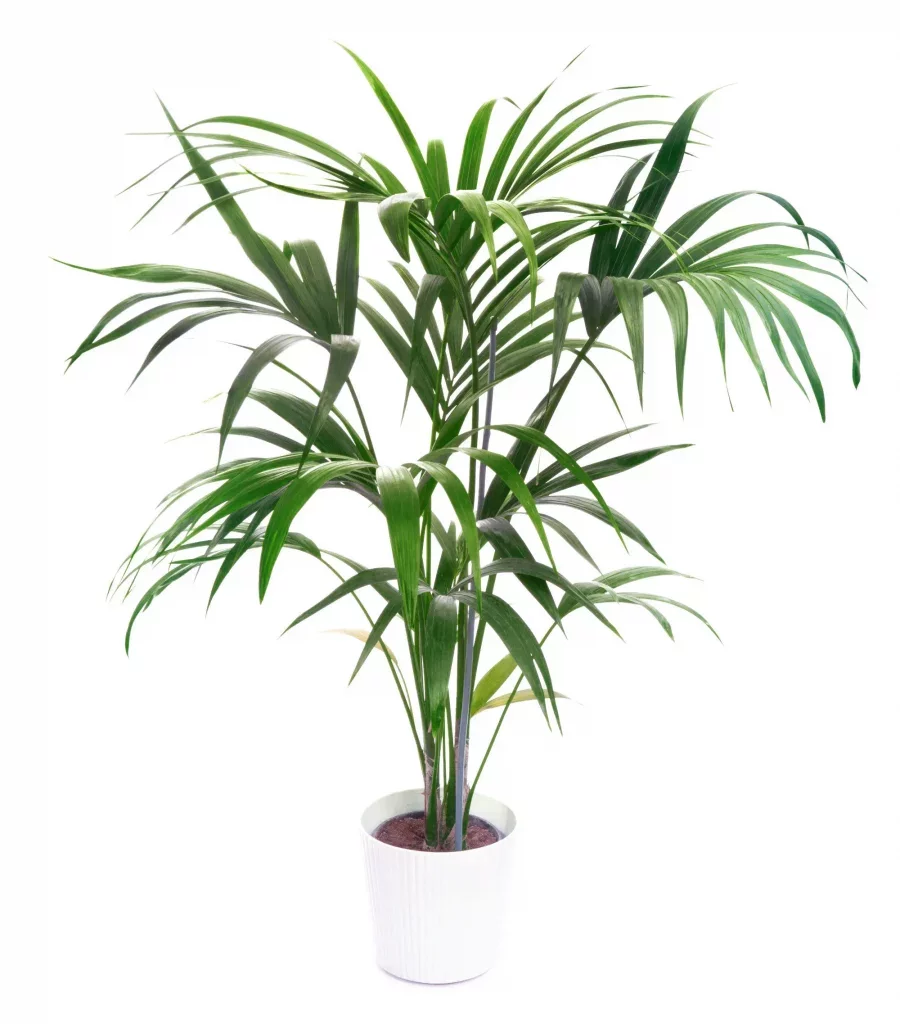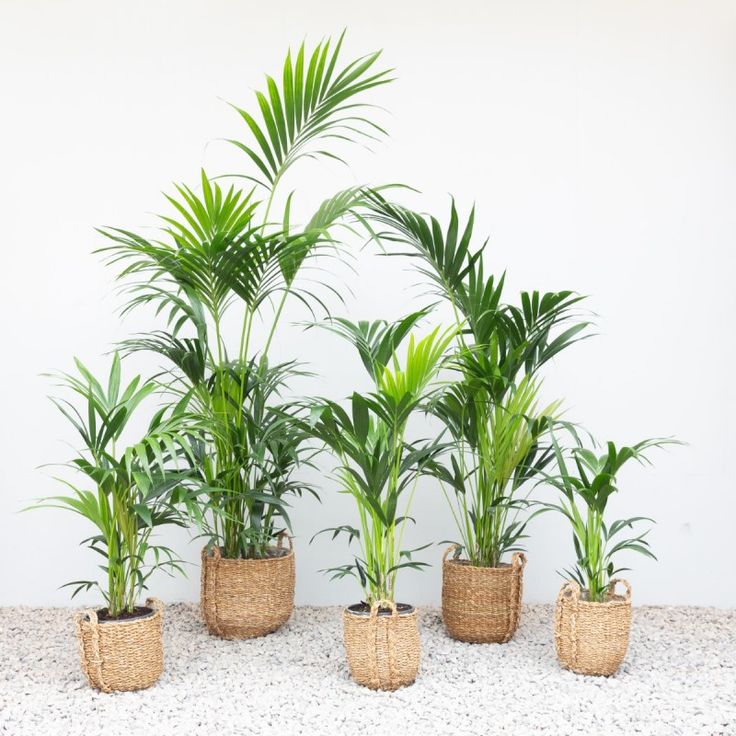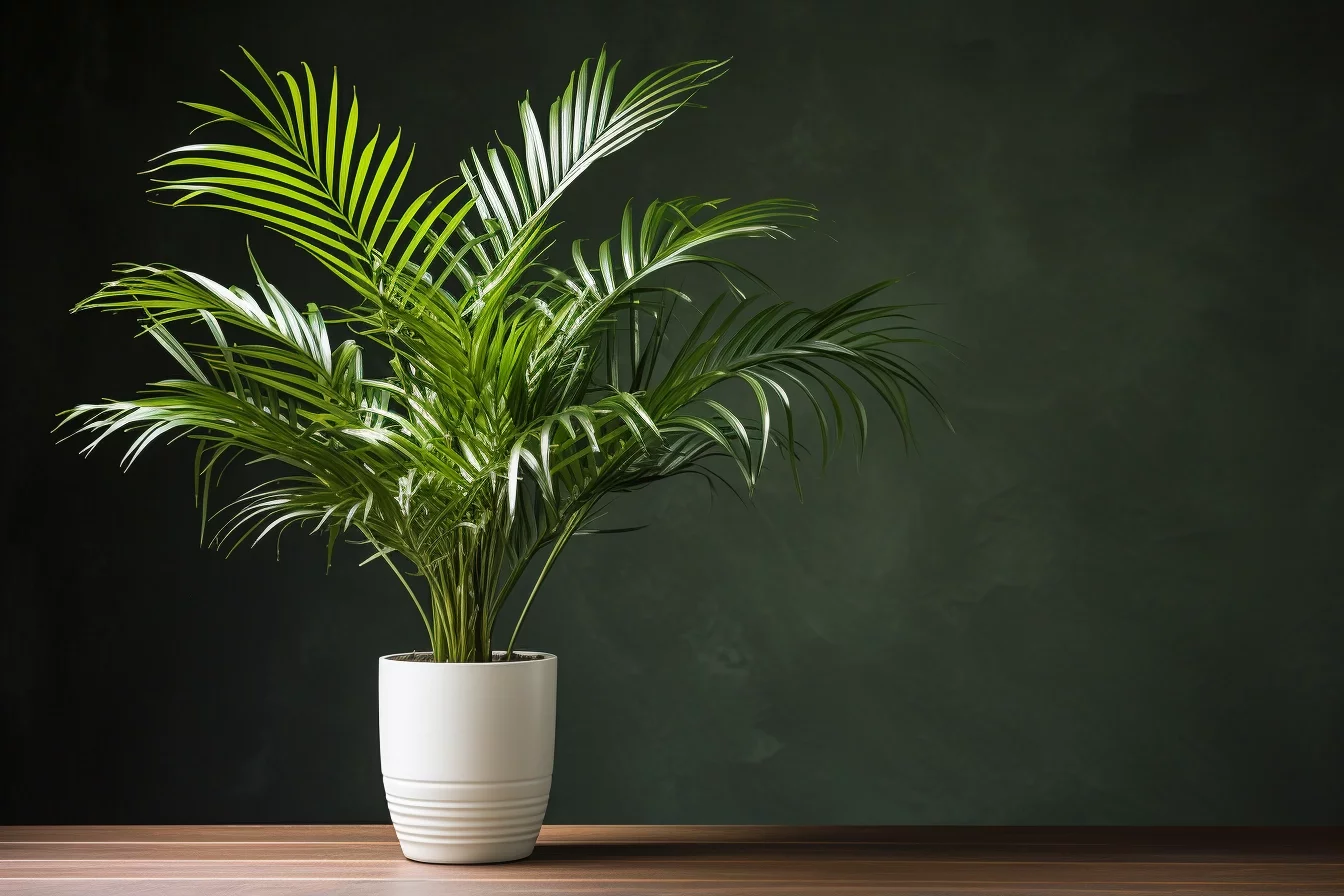Welcome to the ultimate guide on caring for the Kentia Palm, scientifically known as Howea forsteriana. This majestic plant, with its elegant fronds and easy-going nature, has become a favorite in homes and offices around the globe. In this comprehensive guide, we’ll dive into everything you need to know to keep your Kentia Palm thriving. Get ready for a deep dive into the world of this stunning plant!
Nicknames: Paradise Palm, Thatch Palm, Sentry Palm, Flat Palm, Lord Howe Island Palm.

🌿 Understanding Your Kentia Palm
Kentia Palm at a Glance:
- Origin: Native to Lord Howe Island, Australia.
- Growth Habit: Slow-growing, with a graceful, upright stance.
- Leaf Description: Long, arching, dark green fronds.
Why Choose a Kentia Palm?
- Air Purifying: Known for its ability to filter indoor air.
- Low Light Tolerance: Thrives even in low-light conditions.
- Minimalist Aesthetic: Adds a touch of elegance to any space.
🌞 Lighting and Placement
Finding the Perfect Spot
- Indirect Light is Key: Place your Kentia Palm in a spot where it receives bright, indirect light.
- Shade Tolerance: It can adapt to shade, but too little light may slow its growth.
Room Placement Tips
- Living Room: Perfect for corners where it can receive filtered light from windows.
- Office Space: A great addition near a window with sheer curtains.
💧 Watering and Humidity
Watering Wisdom
- Consistency is Crucial: Keep the soil consistently moist, but not waterlogged.
- Check Before You Water: Use the finger test; water when the top inch of soil feels dry.
Humidity Hints
- Likes Humidity: Aim for a humidity level of 40-60%.
- Increase Humidity: Use a humidifier or place the pot on a tray of pebbles and water.
🌱 Soil and Fertilization
Soil Selection
- Well-Draining Mix: Use a potting mix designed for palms or add perlite for extra drainage.
Fertilizing Fundamentals
- Growth Season Feeding: Fertilize lightly during the spring and summer.
- Winter Rest: Reduce fertilization in the cooler months.
🪴 Repotting and Propagation
When to Repot
- Slow Growers: Kentia Palms don’t need frequent repotting. Every 2-3 years is usually sufficient.
Propagation Pointers
- Seed Propagation: The most common method, but requires patience as growth is slow.
✂️ Pruning and Maintenance
Pruning Practices
- Minimal Pruning: Only remove dead or yellowing fronds to maintain its natural shape.
Dust the Fronds
- Keep It Clean: Wiping the leaves with a damp cloth not only keeps the plant looking fresh but also supports photosynthesis.
🛡️ Common Pests and Problems
Pest Prevention
- Watch for Pests: Keep an eye out for spider mites and mealybugs.
- Natural Solutions: Use neem oil or insecticidal soap for treatment.
Troubleshooting Tips
- Brown Tips: Often a sign of under-watering or low humidity.
- Yellow Leaves: Could indicate overwatering or poor drainage.
🌡️ Temperature and Environmental Factors
Ideal Temperatures
- Comfort Zone: Aim for temperatures between 65°F and 75°F (18°C – 24°C).
Avoid Temperature Extremes
- Keep Away from Drafts: Protect your Kentia Palm from cold drafts and sudden temperature changes.
🌟 Styling with Kentia Palm
Interior Design Integration
- Complements Various Styles: From bohemian to modern, the Kentia Palm fits seamlessly into different decor themes.
Creating a Tropical Oasis
- Group with Other Plants: Pair with other tropical plants like Philodendrons or Monsteras for a mini indoor jungle vibe.

FAQ: Everything You Need to Know About the Kentia Palm (Howea forsteriana)
1. What is the ideal lighting for my Howea forsteriana (Kentia Palm)?
💡 Answer: Your Kentia Palm, often referred to as the Paradise Palm, thrives in bright, indirect light. Although it can adapt to lower light conditions, too little light may hinder its growth. Placing it near a north-facing window or a spot with filtered light is perfect. Avoid direct sunlight, especially during the harsh midday hours, as it can scorch the fronds.
2. How often should I water my Thatch Palm (another nickname for Kentia Palm)?
💧 Answer: The watering needs for your Thatch Palm can vary based on environmental factors. Generally, it’s best to water when the top inch of the soil feels dry. This could mean watering every 5-7 days in the summer and reducing to every 10-14 days in the winter. Overwatering can lead to root rot, so ensure the pot has good drainage.
3. Does the Sentry Palm (Kentia Palm) require high humidity?
🌫️ Answer: The Kentia Palm, also known as the Sentry Palm, does appreciate humidity but is quite forgiving if the air in your home is on the drier side. For optimal health, try maintaining a humidity level around 40-60%. If your indoor air is dry, especially in winter, consider using a humidifier or placing a water-filled pebble tray beneath the pot.
4. Is the Paradise Palm (Howea forsteriana) pet-friendly?
🐾 Answer: Yes! One of the wonderful qualities of the Paradise Palm is that it is non-toxic and safe for pets. This makes it a fantastic choice for households with curious cats and dogs.
5. How fast does the Howea forsteriana grow?
📏 Answer: The growth rate of Howea forsteriana is relatively slow compared to other palms. Typically, it will grow about 6 to 10 inches per year. Patience is key with this elegant palm! Its slow growth, however, makes it an ideal indoor plant as it won’t outgrow its space too quickly.
6. What are the common problems to look out for in Kentia Palms?
🚫 Answer: While Kentia Palms are relatively hardy, they can encounter a few issues. Brown leaf tips may indicate under-watering, low humidity, or a buildup of minerals from tap water. Yellowing leaves can be a sign of overwatering. Also, keep an eye out for pests like spider mites, especially in drier environments.
7. How should I fertilize my Kentia Palm (Howea forsteriana)?
🌿 Answer: Fertilizing your Kentia Palm is important for its growth and health. Use a balanced, water-soluble fertilizer once every two months during the growing season (spring and summer). Avoid fertilizing in the winter months as the plant’s growth slows down. Over-fertilizing can harm the plant, so it’s crucial to follow the recommended amounts.
8. Can I repot my Thatch Palm? How often should this be done?
🪴 Answer: Yes, you can repot your Thatch Palm, though it’s rarely needed due to its slow growth rate. It’s generally recommended to repot every 2-3 years, or when you notice the roots are becoming crowded in the current pot. When repotting, choose a pot that’s slightly larger than the current one and use well-draining potting soil.
9. How can I prune my Paradise Palm to keep it looking its best?
✂️ Answer: Pruning your Paradise Palm is quite straightforward. Simply trim off any yellow or brown fronds at the base of the stem using clean, sharp scissors or pruning shears. Avoid over-pruning, as this can stress the plant. Regularly removing dead leaves helps to encourage healthy growth and maintains the aesthetic appeal of your palm.
10. Where is the best place in my house to position my Sentry Palm for optimal growth?
🏡 Answer: The best spot for your Sentry Palm is a location where it can receive bright, indirect light. An ideal place could be near a window with sheer curtains or in a room with north or south-facing windows. Avoid placing it in direct sunlight or very dark corners. Moderate ambient room temperatures and protection from drafts will also contribute to its well-being.
By following these detailed care tips and understanding the needs of your Kentia Palm, you can ensure that your Howea forsteriana remains a healthy and elegant addition to your indoor space for years to come! 🌴🌿
5 Compelling Reasons to Add Kentia Palm to Your Indoor Plant Collection 🌴
1. Enhances Indoor Air Quality 🍃
One of the most significant benefits of the Kentia Palm is its ability to purify the air. It’s renowned for filtering out indoor air pollutants like benzene, formaldehyde, and trichloroethylene. By improving air quality, it creates a healthier living environment, which is especially beneficial for those with allergies or respiratory issues.
2. Low Light Adaptability 🌞➡️🌿
Kentia Palms are champions when it comes to thriving in low-light conditions. Unlike many houseplants that require bright, indirect sunlight to prosper, this palm can survive and even grow in shaded areas or rooms with minimal natural light. This makes it an ideal plant for spaces like bedrooms or offices with limited sunlight exposure.
3. Easy Care and Low Maintenance 💧
If you’re new to indoor gardening or simply don’t have the time for high-maintenance plants, the Kentia Palm is a perfect choice. It’s forgiving and requires minimal care, making it ideal for busy individuals. It doesn’t need frequent watering, tolerates a range of indoor temperatures, and doesn’t require regular pruning.
4. Adds Elegance and Aesthetic Appeal 🌴
The Kentia Palm is a visually striking plant with long, arching fronds that add a touch of elegance and tropical flair to any room. Its lush green foliage can complement various interior design styles, from modern minimalist to bohemian chic. It’s a natural and stylish way to enhance the decor of your home or office.
5. Non-Toxic and Pet-Friendly 🐾
For households with pets, the safety of indoor plants is a crucial consideration. The Kentia Palm is non-toxic to both cats and dogs, making it a worry-free choice for pet owners. You can enjoy the beauty and benefits of this palm without concerns for your furry friend’s well-being.
Incorporating a Kentia Palm into your indoor plant collection means more than just adding greenery. It’s about improving your living space’s air quality, aesthetics, and overall ambiance with minimal effort. It’s a choice that offers both practical benefits and natural beauty, making it a superb addition to any indoor environment. 🏡🌿✨
📚 Further Reading and Resources
- Books: “The Complete Houseplant Survival Manual” by Barbara Pleasant offers more in-depth insights.
- Online Resources: Websites like Gardening Know How provide a wealth of information.
Caring for a Kentia Palm is a rewarding experience that brings a slice of tropical paradise into your living space. With the right care and attention, your Kentia Palm will grow into a stunning focal point in your home or office. Embrace the journey of nurturing this beautiful plant, and enjoy the lush, leafy ambiance it brings to your environment. Happy planting! 🌴💚

